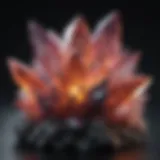Cuts of Rings: Exploring Aesthetic and Functionality
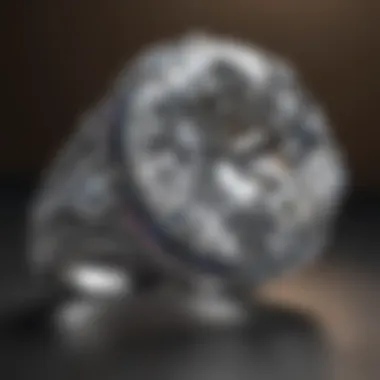

Intro
When it comes to rings, the cut of the gemstone is a critical aspect that not only affects its appearance but also its performance in terms of light reflection and brilliance. Understanding how various cuts influence the overall aesthetics of a ring can deepen your appreciation for the art of jewelry design. In this guide, we will embark on a journey through the fascinating realm of ring cuts, exploring their historical significance, the technology behind them, and how they intersect with personal style and preference.
As we dive into this topic, it is essential to first comprehend the foundation upon which these cuts are based—the gemstones themselves. Knowing the nuances of different gemstones and their properties will enrich our understanding of why certain cuts are favored over others and how they can enhance each piece of jewelry.
Overview of Gemstones and Minerals
Before we analyze the cuts of rings, let's take a moment to appreciate the gemstones that adorn them. Gemstones, formed over millennia within the Earth's crust, vary dramatically in appearance, hardness, and rarity. Their evolution encompasses more than mere mineral composition; it incorporates the storytelling aspect that each stone brings along its journey to market.
History of Gemstone and Mineral Use
Since ancient times, gemstones have held value. Tribes across the globe have adorned themselves with these natural treasures for both aesthetic and cultural significance. In ancient Egypt, turquoise symbolized protection and good fortune, while sapphires were considered a favorite of royalty. Moreover, different cultures have ascribed varying meanings to stones; for instance, garnets were believed to ensure safety during voyages.
Significance in Culture and Society
Gemstones often transcend their physical form, becoming symbols of love, power, and status. Their presence in engagement rings reflects a commitment that can bridge generations. The diamond, for example, has become ingrained in the cultural consciousness as a token of everlasting love. In contrast, birthstones—such as the vibrant emerald for May—carry personal meaning, reinforcing connections to identity and familial ties.
Epilogue
In summary, the significance of gemstones in culture highlights how integral they are not just as decorative elements but also as storytellers of humanity's shared history. With this understanding, we can now navigate the different cuts of rings, aligning them with the beauty and intrigue that gemstones inherently possess.
Intro to Ring Cuts
Rings are more than mere adornments; they tell stories, symbolize commitments, and often become heirlooms passed down through generations. One key aspect that can transform an ordinary ring into something extraordinary is the cut of the gemstone. Understanding the importance of cut allows enthusiasts, collectors, and designers to appreciate its role in crafting jewelry that captures attention and holds meaning.
When discussing ring cuts, one must consider how light interacts with these carefully crafted gems. A well-designed cut can enhance brightness, sparkles, and color, capturing the allure of the stone and drawing the eyes of onlookers. This is especially significant in a world where the market is saturated with various styles and types of jewelry. What ultimately sets a ring apart from the rest often boils down to its cut, making it essential knowledge for anyone involved in the jewelry scene.
Understanding the Importance of Cut
A gemstone's cut is not merely about the intricate facets on its surface; it speaks to the very essence of its beauty. In the industry, this is often conveyed through the term "light performance," which encompasses how effectively a stone reflects, refracts, and disperses light. Different cuts can significantly influence these characteristics. For instance, the classic round brilliant cut is designed to capitalize on light refraction, resulting in a fantastic sparkle that many deem most desirable.
Moreover, the cut also dictates the stone’s overall shape and aesthetics. A well-executed cut can preserve the stone's original size while maximizing its visual impact, transforming a simple gemstone into a captivating centerpiece. Conversely, a poor cut can diminish a stone’s natural beauty, leaving it lackluster and unimpressive. Therefore, anyone who wishes to invest in jewelry—whether for personal use or resale—should prioritize the quality of the cut.
The Relationship Between Cut and Value
When it comes to grading the value of a gemstone, cut is one of the 3 Cs: Cut, Color, and Clarity. In fact, the cut often holds greater weight than the others when evaluating a stone’s worth. A high-quality cut can elevate the perceived value of a gemstone, while a poorly cut stone—even if it boasts incredible color and clarity—may fetch a lower price.
For example, a princess cut diamond can vary in price significantly based on its cut quality. Premium cuts yield a superior brilliance, leading to higher market demand and ultimately increased value. The differences can be so pronounced that a collector might find themselves willing to pay those extra dollars for a ring that truly shines.
In short, understanding the relationship between cut and value is crucial. It empowers individuals to make informed choices, whether they're selecting a piece for special occasions or browsing for something unique to enhance their collection.
A well-cut gemstone isn’t just visually appealing; it represents a blend of artistry and technical skill that elevates it to a status of value and worth.
By recognizing the significance of ring cuts, one can appreciate not only the craftsmanship involved but also the emotional resonance these pieces carry. Investing in a well-cut ring isn’t merely about aesthetics—it’s about acquiring a piece of art that embodies beauty, history, and value.
Basic Types of Cuts
Understanding the basic types of cuts is crucial for anyone who has an interest in jewelry, whether you’re a gemstone enthusiast collecting unique pieces, a designer crafting new styles, or simply someone selecting a meaningful ring. Each cut serves not only an aesthetic purpose but also affects light reflection and the stone's overall brilliance. Choosing the right cut can elevate the ring's visual impact and its value.
Brilliant Cuts
Brilliant cuts are perhaps the most popular and recognized shapes in the realm of gemstone cutting. These cuts are designed to maximize the reflection of light, creating a fiery sparkle that captures attention. The classic round brilliant cut, which consists of 58 facets, is a prime example. It reflects light exceptionally well, allowing diamonds to shine brilliantly.
For seasons, the round brilliant has reigned supreme, drawing admirers for its unmatched ability to create a play of light. Yet, there are variations like the modified brilliant cuts, which may include additional facets or different proportions, enhancing the stone's unique character without compromising its brilliance. It's an important choice for anyone seeking the quintessential sparkle in their ring.
"A brilliant cut not only enhances the beauty of the stone but also adds a touch of timeless elegance to whatever piece of jewelry it adorns."
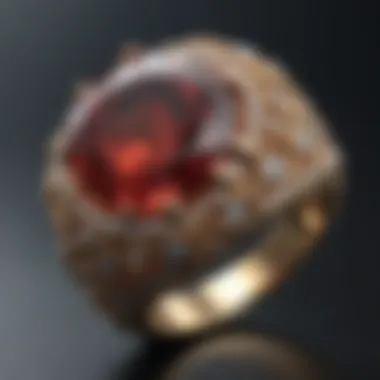

Step Cuts
Step cuts contrast greatly with brilliant cuts, focusing more on clarity and color rather than sheer sparkle. They are characterized by their rectangular or square shape and long, flat facets, resembling steps—hence the name. The emerald cut and the Asscher cut are two well-known examples.
These cuts often allow light to enter a stone more directly, revealing its internal characteristics. In stones like emeralds, where inclusions might mar a brilliant cut, step cuts can highlight the stone's beauty instead. Collectors and connoisseurs often lean towards step cuts for their sophisticated and elegant lines. A well-cut step stone can claim its own charm, showing its color and clarity in a way that is utterly captivating.
Mixed Cuts
Mixed cuts combine elements of both brilliant and step cuts. They incorporate facets designed to maximize sparkle while also allowing light to penetrate the stone, showcasing its color and clarity. These cuts come in various styles, with the most popular being the princess cut, which has gained immense popularity in recent years.
Mixed cuts can offer a versatile option for those wanting the best of both worlds. Sure, they keep the bright, flashing light typical of brilliant cuts but add structural elegance found in step cuts. This ability to harmoniously blend these characteristics has led to their rapid acceptance in contemporary jewelry design.
When considering a ring's design, it's essential to delve into these basic types of cuts, reflecting on what aspects might be most appealing based on personal preference and the nature of the stone itself. The cut not only determines how a gemstone will appear but a well-chosen cut resonates with individual style and aesthetic goals.
Popular Ring Cuts
The world of ring cuts is intricate and fascinating, with each shape telling its own story. Popular ring cuts hold a special significance in this realm as they represent the most sought-after styles, often becoming the standard by which beauty is measured in jewelry. These cuts not only enhance the aesthetic appeal of a gemstone but also influence how the stone interacts with light, which plays a vital role in the overall visual impact. Understanding these cuts aids not just in the appreciation of artistic design but also in making informed purchasing decisions.
Each type of popular cut comes with its unique advantages and considerations. Some cuts are better suited for certain gemstones, while others may reflect light in a manner that creates exceptional brilliance. By familiarizing oneself with these variations, aspiring collectors or passionate enthusiasts can better tailor their choices to individual preferences, styles, and occasions.
Round Cut
The round cut often claims the title of being the most classic and popular choice in rings. This cut emphasizes brilliance and fire, making use of its symmetrical shape to maximize light return. Whether it’s an engagement ring or a piece of fine jewelry, the round cut is versatile and timeless.
What sets the round cut apart is its specific faceting pattern—typically featuring 58 facets, which allow light to play beautifully across the surface of the stone. This cut has a notable ability to disguise inclusions and display clarity, making it a favorite among couples wanting something splendid yet practical. The round cut is known for its appeal across various gemstone types, from diamonds to sapphires, serving as a reliable choice for capturing visual interest.
Princess Cut
The princess cut is a marvel of modern design, often celebrated for its chic, contemporary aesthetics. This square or rectangular shape showcases a unique combination of shape and brilliance, allowing for a bold yet delicate look. One of the appealing aspects of the princess cut is its ability to retain significant carat weight while offering an impressive array of light dispersion.
With sharp corners and meticulously angled facets, the princess cut can make even smaller stones appear grand, effortlessly enhancing the overall appearance. It’s incredibly popular among those who favor something unique yet remains within traditional realms. Couples looking for something different often find that the princess cut strikes just the right chord, all the while adapting seamlessly to a variety of styles.
Emerald Cut
Unlike the more glittering alternatives, the emerald cut is recognized for its sophistication and elegance. Its rectangular shape, with broad, flat facets, reflects light in such a way that it generates a unique – almost tranquil – aura. This cut reveals the stone’s clarity and color beautifully while exuding a vintage charm that has stood the test of time.
The emerald cut is particularly suited for larger gemstones as the open facets emphasize the stone’s quality and inherent characteristics. For gemstone enthusiasts, the emerald cut demands a discerning eye, as its beauty is greatly derived from purity and clarity. Jewelers often showcase the emerald cut in timeless pieces, making it a favored choice for those who appreciate the subtleties of design.
Asscher Cut
The Asscher cut offers a blend of vintage glamour and modern sophistication. Characterized by its square shape and layered stepped faceting, this cut captures light in a distinctive way that can create a mesmerizing display. It shares similarities with the emerald cut but presents itself with more brilliance and flash, often giving it a more elevated appearance.
Originally created in the early 20th century, the Asscher cut evokes a sense of nostalgia while keeping up with contemporary design trends. Ideal for those who love a statement piece, this cut has gained considerable popularity in recent years, with collectors taking special note of its artistry and finesse.
Cushion Cut
The cushion cut is often described as a consummate blend of the vintage and the modern. Its pillow-like shape combines rounded corners with large facets, allowing it to reflect light in enchanting patterns. This cut retains a nostalgic essence reminiscent of older jewelry styles yet aligns beautifully with present-day tastes, catering to a wide audience.
A cushion cut design can accommodate various sizes and types of gemstones, making it a versatile choice for significant pieces, including engagement rings. This adaptability, along with its captivating sparkle, is what makes the cushion cut a staple in many jewelers' collections.
Oval Cut
Regaining popularity, the oval cut presents an alluring form that captures attention without straying too far from traditional aesthetics. A shape well-suited for elongating the fingers, it offers a unique twist on the classic round cut. With its facets designed to enhance brilliance, the oval cut can deliver mesmerizing visual effects that appeal to modern buyers.
While resembling the round cut in terms of light performance, the oval cut allows for greater carat weight to be displayed, making it a favorable option for those wanting a larger appearance without the related cost of a round diamond.
Marquise Cut
The marquise cut, often associated with grace and elegance, presents an elongated shape that highlights a gemstone's size. Its unique silhouette is reminiscent of a boat, lending an aristocratic demeanor to any piece of jewelry. This cut's design facilitates an incredible display of light, reflecting radiance that transforms the piece into a statement of luxury.
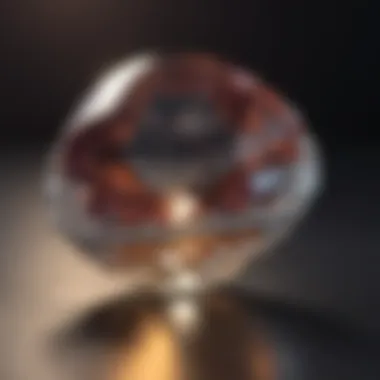

Moreover, the marquise cut blends well with various styles, whether it’s set alone on a delicate band or surrounded by other stones in intricate designs. It's essential to consider practicality here, as this cut's points make it somewhat susceptible to chipping; still, its beauty continues to enchant those looking for something slightly unconventional.
Advanced Cutting Techniques
The world of jewelry design has evolved beyond traditional methods and now embraces advanced cutting techniques that enhance the beauty and uniqueness of each gemstone. This section delves into the methods, technologies, and artistry behind these innovative approaches. Understanding advanced cutting techniques is crucial for jewelry enthusiasts and designers who seek to elevate their creations beyond standard offerings. These methods not only emphasize the aesthetic appeal but also impact the functionality and perception of the gemstones involved.
Faceting Methods
Faceting is a cornerstone of gemstone cutting that takes precision and artistry to a whole new level. It involves creating multiple flat surfaces, or facets, on the stone, which allows light to enter and reflect at various angles. The interplay between light and the cut can turn a simple stone into a mesmerizing work of art. Different faceting strategies exist, and each affects the stone's brilliance and overall appeal.
- Standard Faceting: This is the most common method where traditional proportions are followed to maximize the light's reflection.
- Brilliant Cut Faceting: This method often features numerous facets, typically seen in round diamonds, to enhance sparkle.
- Fantasy Cuts: Here, the cutter takes creative liberties, producing unique patterns that might not conform to conventional styles.
The choice of faceting method can be influenced by the type of gemstone being cut. Softer gems may require lighter cutting techniques to avoid damage, while harder stones like diamonds can withstand more aggressive methods. This cutting process is not only about aesthetics; every facet serves a purpose in revealing the stone’s character and presence.
Laser Cutting Technology
In recent years, technology has made substantial advancements in the field of gemstone cutting. One of the most noteworthy is the use of laser cutting technology. This high-precision method allows for intricate designs and greater control over the cutting process.
Laser cutting provides several advantages:
- Precision: With a laser, it’s possible to achieve a level of detail that manual methods can't replicate.
- Consistency: Each gemstone can be cut uniformly, maintaining the same standards across multiple pieces.
- Speed: Laser technology can significantly reduce the time it takes to produce a finished stone.
However, this method also requires skilled operators who understand not just the technology, but also how to work with different types of gems. The laser cutting process can also generate heat, which necessitates cooling mechanisms to protect the stone from damage. Overall, laser cutting technology has revolutionized the industry, allowing for a more modern approach to age-old practices.
Unique and Custom Cuts
The interest in individuality and unique designs has led to the rise of custom cuts in recent years. These are often tailored to the specific desires of clients or the distinctive qualities of particular gemstones. Unique cuts do not follow traditional shapes or patterns, offering a distinct flair that sets them apart in the jewelry market.
- Personalization: Customers can request specific elements, whether it be an unusual shape or a particular pattern that resonates with their personal story or preferences.
- Artistic Expression: Designers often create one-of-a-kind pieces that showcase their creativity, pushing the boundaries of standard designs.
- Symbolism: Custom cuts can also include motifs or meanings that are significant to the wearer, making the piece more than just jewelry—it's a representation of individual identity.
In a market where mass production is common, unique and custom cuts stand out as a testament to art and craftsmanship, offering something truly singular for those who appreciate the finer details of design.
Custom cuts allow jewelry to tell a story, showcasing not just the stone itself, but the journey it embodies for the wearer.
Historical Perspectives on Ring Cuts
Understanding the historical perspectives on ring cuts offers invaluable insights into how artistry, culture, and technology converge in the creation of these adornments. Historically, rings have symbolized not only beauty but also status, love, and commitment. Their cuts evolved dramatically over centuries, influenced by various societal changes, trends, and technological advancements. This section explores these facets in depth.
Evolution of Cutting Styles
The journey of cutting styles can be traced back to ancient civilizations where gemstones were often crafted with primitive tools. Initially, the emphasis was not on perfection but rather the sheer visibility of the stone, focusing on its natural shape. Ancient Egyptians cut stones to enhance their beauty in a rudimentary fashion, primarily using hand tools.
As we moved into the Renaissance, a more sophisticated approach emerged. The introduction of the brilliant cut in the 17th century marked a turning point. This cut, designed to maximize the diamond's brilliance and fire, doubled down on the importance of light reflection. The iconic round brilliant-cut diamond, still revered today, owes its popularity to this transformative period, which saw artisans push boundaries of what was technically possible, combining artistry with burgeoning scientific understanding of light.
By the 20th century, advancements in technology led to more precise cutting techniques, allowing for intricate designs like the princess cut or the emerald cut to gain traction. With the advent of laser technology, jewelers gained finer control, enabling unique cuts tailored to individual gemstones and preferences. As a result, we now experience a diverse range of cuts that cater specifically to maximizing each gem's true potential.
Cultural Influences on Ring Design
Cultural context deeply influences ring design and cutting styles. Different societies attributed varied meanings to gemstones and their configurations. For example, in many Asian cultures, specific stones like jade are venerated not just for their beauty but also believed to bring good fortune and protection. The cuts varied accordingly, leaning towards softer, more rounded designs to reflect harmony and balance.
In contrast, Western cultures have largely gravitated towards angular cuts emphasizing brilliance and clarity. The Asscher cut and cushion cut, for instance, emerged as favorites, also resonating with Art Deco and Modernist movements that favored geometric and innovative designs. The portrayal of rings in popular media also shaped public preference and aspirations, leading consumers to desire iconic shapes and sizes that symbolize status and affection.
"Rings are not just adornments; they tell stories of love, culture, and the passage of time embedded in every facet."
Through studying the historical context of ring cuts, we gain an appreciation for this evolution that mirrors broader cultural narratives. As global exchanges continue to shape consumer preferences today, the history of ring cuts serves as a lens through which we can visualize the journey of human expression and artistic endeavor. This thereby enables a deeper understanding of how the past informs contemporary tastes and choices in ring design.
Choosing the Right Cut for You
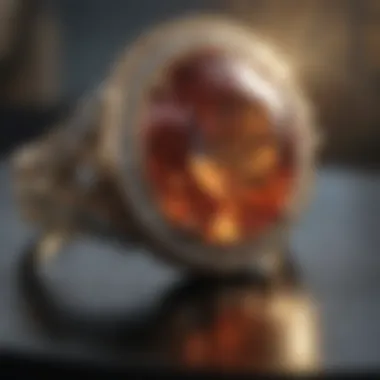

Choosing the right cut for your ring is more than just a matter of personal preference; it’s a reflection of your individual style, the gemstone you’ve selected, and the overall look you want to achieve. Understanding the nuances involved in selecting a cut can significantly enhance the beauty and emotional value of a ring, whether it’s for an engagement, a special occasion, or simply a personal treat. It encompasses matching the right cut with stone types, being mindful of your style, and weighing various factors that influence your decision.
Matching Cuts with Gemstone Types
Different gemstones possess unique qualities that can be accentuated by certain cuts. For instance, a round brilliant cut often maximizes light reflection, making it a favored choice for diamonds due to their dispersive properties. On the other hand, a softer stone like amethyst may suit a cushion or oval cut, allowing its color to shine through without the risk of chipping during setting. Here’s a brief outline of suitable cut-gemstone pairings:
- Round Cut: Works beautifully with diamonds but also complements sapphires and rubies.
- Princess Cut: Another great choice for diamonds; less commonly paired with colored stones, but can work well with topaz.
- Emerald Cut: Best suited for larger, clear stones like emeralds or aquamarines, where depth adds to the visual appeal.
- Cushion Cut: Versatile and works with a range of stones, from diamonds to garnets.
Each stone has its own character, and the ideal cut should amplify that, ensuring you get a ring that not only looks great but feels personal and meaningful.
Considerations for Personal Style
Your personal style plays a pivotal role in the selection process. Are you drawn to classic elegance or modern aesthetic? Do you prefer a minimalist look, or do you lean towards intricate designs? The answers to these questions can guide your choices. When considering personal style, keep the following aspects in mind:
- Lifestyle: Choose a cut that fits your everyday life. An active lifestyle may call for a lower profile setting, like a bezel or flush set.
- Color Palette: What colors do you wear most often? A cut that enhances the colors in your wardrobe can complement your overall look.
- Symbolism: Engage with stone meanings or personal symbols you hold dear; they’ll make your choice intentional.
Ultimately, the ring should align with who you are, serving as a daily reminder of your values and aesthetics.
Factors Influencing Selection
Several factors can sway your decision when choosing the perfect ring cut:
- Budget: Certain cuts may be more cost-effective, particularly those that maximize carat weight, such as the emerald cut compared to more wasteful cuts like the marquise.
- Occasion: Special events may call for more robust styles. Consider how frequently the ring will be worn— a more durable cut might be preferable for daily wear.
- Current Trends: While personal preference is key, it can help to be informed about current fashion trends in the jewelry world. Keeping an eye on what’s popular might inspire your choice without compromising your unique taste.
- Expert Opinions: Consulting with a jeweler or designer can offer insights that may not be obvious at first glance. They can guide you toward cuts that work well with your chosen gemstone while considering craftsmanship.
"Selecting a ring cut is like composing a personal symphony—each note carries its own weight, and together they tell your unique tale."
The Future of Ring Cutting
The evolution of ring cutting is a fascinating journey that intertwines art, science, and technology. As we stand at the brink of new possibilities, understanding the future of ring cutting is crucial. This topic not only enriches our appreciation for gemstones but also influences the jewelry market. Advances in cutting methods can lead to more stunning designs and optimal use of resources, impacting both aesthetics and sustainability.
New techniques and trends are reshaping how designers and enthusiasts approach the creation of rings. They open doors for innovations that were unthinkable just a few years ago. Let's dive into what's on the horizon.
Innovative Techniques and Trends
Recent advances in gem cutting rely heavily on technology, enabling jewelers to harness precision that was previously unattainable. Here are some notable innovations:
- 3D Printing: Prototyping designs through additive manufacturing allows for intricate designs that traditional techniques struggle to replicate. This method can cater to bespoke needs, offering a unique touch without compromising on quality.
- Computer-Aided Design (CAD): CAD technology not only boosts efficiency but also provides the flexibility to visualize gems in various cuts and styles quickly. This aids jewelers in exploring different design paths before committing to physical cutting.
- Enhanced Laser Technology: Modern laser cutting tools have made it possible to achieve clean and precise cuts. These innovations minimize waste and maximize light reflection, ultimately elevating the beauty of each piece.
"The advancements in cutting technology have revolutionized how we perceive and create jewelry today."
Moreover, social media and online platforms contribute to the changing landscape. Designers can showcase their creations to a global audience, garnering feedback and inspiration in real time. This interaction further fuels innovation and diversity as trends spread swiftly across borders.
Sustainability in Gem Cutting
Considering environmental impact is essential in today's world. Sustainable practices in gem cutting address ethical sourcing and minimize ecological footprints. Here's how the industry is adapting:
- Recycled Materials: Using previously uncut stones or repurposed gemstones reduces demand for new mining, preserving the environment.
- Ethical Mining Practices: Organizations are taking steps to ensure that mining operations are socially and environmentally responsible. This has implications for the sourcing of gemstones, promoting fairness and responsibility.
- Energy Efficiency: Implementing advanced cutting methods that require less energy can significantly reduce the carbon footprint. Techniques like laser cutting exemplify the shift towards more efficient processes.
Many consumers are now demanding transparency regarding the origins of their jewelry. Designers who embrace eco-friendly practices can not only appeal to a conscientious audience but also pave a path toward a more sustainable future. By marrying traditional craftsmanship with innovative technology, the future of ring cutting can indeed sparkle brighter.
The End
In the intricate tapestry of ring design, the cut of a gem stands out as a pivotal element. This article has taken you through a comprehensive journey, revealing how various cuts not only enhance the beauty of gemstones but also influence their value and desirability. Understanding the nuances of cuts is essential for anyone involved in jewelry, from collectors to designers.
Each ring cut has its unique personality and charm. For instance, a brilliant cut is celebrated for its ability to reflect light in a dazzling manner, making it a favorite for engagement rings. Conversely, the elegance of the emerald cut appeals to those who appreciate a more understated sophistication. When you choose a cut, you’re not just selecting a preference; you’re making a statement about style and individuality.
Beyond aesthetics, we’ve explored the implications of cutting techniques on gemstone durability and how advancements in technology, like laser cutting, have transformed traditional practices. These innovations not only streamline the process but also open up new avenues for creativity in design.
Furthermore, the study of cuts inevitably leads to discussions about sustainability—a concern increasingly at the forefront of our collective consciousness. By understanding the historical context and future trends in ring cutting, you can make informed decisions that align with both your values and desires.
"The significance of cut in jewelry design can't be overstated. It’s the cut that dictates not only how a gemstone sparkles but also how it resonates with the wearer."
As you proceed on your journey—whether you are selecting a ring for a special occasion or designing a signature piece—consider what you’ve learned about cuts. Reflect on what each choice signifies about your taste and vision. Ultimately, the right cut can elevate a simple piece of jewelry into a timeless treasure, encapsulating not only beauty but also meaning.
In summary, the world of ring cuts is as diverse as it is profound, and this exploration equips you with the insights needed to appreciate and select your gems wisely. Embrace the journey of finding the perfect cut—it holds the potential to transform your personal collection or cherished gift.




